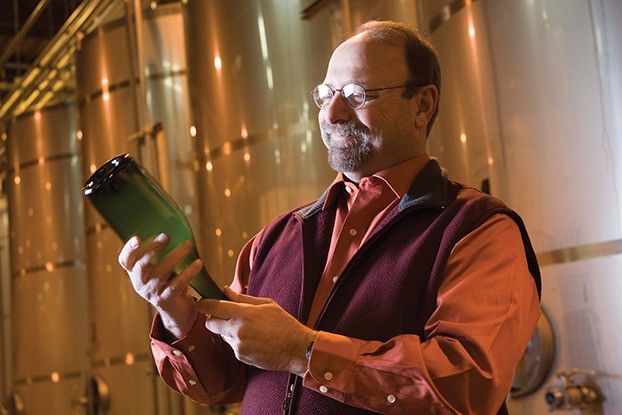I have never seen a statistic but more Champagne and sparkling wine must be consumed during November and December than any other time of year. The best prices are in November and December because the vendors want your dollars. June, the wedding month, is an excellent time to look for those good prices too.
All Champagne is sparkling wine but not all sparkling wine is Champagne. To be accurately called Champagne, the wine must come from the Champagne region of France, which is 90 miles northeast of Paris. It is about 45 minutes by train from Paris–almost six hours from Bordeaux. To the purist, sparkling wines made outside of Champagne must not be labeled as Champagne.
Many French Champagne houses have California branches. Moet et Chandon has Domaine Chandon, G.H.Mumm has Mumm Napa, Roederer has Roederer Estate, Taittinger has Domaine Carneros Taittinger.
However, nothing in the world tastes like true French Champagne. It is attributed to “terroir” which strictly translated means the land. Loosely translated, terrior is a sense of place encompassing geography, geology and climate. Even though these many French Champagne houses have American branches, nothing compares to the yeasty, nuttiness of true Champagne.
When we visited Champagne several years ago, we stayed in Reims, the largest city. Rheims, as it is also known in English, is a throbbing metropolis with a vibrant night life in the middle of an agricultural area. It is a great place to stay and then take the train (or a taxi since France was having another of their constant strikes) to Epernay where many of the major Champagne houses are located.
Driving through Champagne, we were surprised at how many wineries there were, finding out later that there are over 16,000 producers albeit some are very tiny. We happened to stop at one which turned out to be a teaching venue. The students were delighted that we stopped which allowed them to open bottles for tasting. My husband speaks passable German which didn’t help but we communicated well with hand motions and the students’ small knowledge of English.
Sparkling wines come from everywhere: Spain, Germany, Australia, Italy. In Italy, the major sparkling wines are Asti Spumante and Prosecco. We had a turkey dinner with all the fixings and enjoyed prosecco. It was one of the best matches for turkey. In Champagne domestic sparkling wines, chardonnay and pinot noir are the predominant grapes. In Italian Prosecco, pinot grigio, pinot bianco and glera are the main grapes. Spanish Cava uses grapes native to Spain: xarello, macabeo, and parellada.
Our own Washington State produces wonderful sparkling wine. Chateau Ste. Michelle has revamped its previous Domaine Ste. Michelle label to simply Michelle. Winemaker Rick Casqueiro developed the original Domaine Ste. Michelle and gathered many awards from many wine critics. He again is at the sparkling wine helm of Michelle. “We have enhanced…for more body and concentration,” said Casqueiro. “The wines are elegant, with bright flavors, beautiful structure and crisp acidity.” Michelle has brut, extra dry and a rose.
The Michelle brut rose’ was featured as Wine of the Week in Wine Press Northwest: “Who bottles the most pinot noir in Washington State? It’s Michelle winemaker Rick Casqueiro with this delectable sparkling presentation of pinot noir (93%). Prepare for its pleasing mousse and nose-tickling aromas of strawberry freezer jam, Rainier cherry, cranberry, rhubarb pie and apricot.”
Trevari Winery of Yakima has a wonderful story to tell. With just a year existence under its belt, an aide of Hillary Clinton stopped by the tasting room. Trevari ended up in the White House being served at a state dinner. Trevari offers only sparkling but has a huge lineup: gewürztraminer, riesling, syrah, pinot gris, muller thurgau, extra brut, blanc de blanc.
Succinctly, sparkling wine is made the same as ‘still wine’ at first. The ‘still wine’ undergoes a second fermentation in the bottle to become sparkling with the addition of yeast and a small amount of sugar. Stored horizontally, it is temporarily capped with a crown cap or other sturdy temporary plug. Champagne houses have many other choices: longer fermentation, declaring a vintage, aging on lees, stir or not to stir. These choices result in the final product. We consumers then vote with our dollars!
Very cheap sparkling wines — those found on the bottom shelf in the grocery store —get their effervescence by injecting carbon dioxide. They are often used to mix with orange juice for mimosas for a holiday brunch. I personally would prefer using a better sparkling like Michelle or California Chandon for mimosas.
To open a bottle safely: After removing the metal bale, I place a clean dishtowel over the top of cork. Twist the cork one direction while turning the bottle the other direction. The dishtowel keeps the cork from taking out the host’s eye and also sops up any errant spills. When we were in Champagne, we were treated to the celebratory saber opening. The saber was swung down and neatly lopped off the top of the bottle. Do not try this at home.
Madame Bollinger from the House of Bollinger famously said:
“I drink it when I’m happy and when I am sad. Sometimes I drink it when I’m alone. When I have company, I consider it obligatory. I trifle with it if I’m not hungry and drink it when I am. Otherwise, I never touch it—unless I am thirsty.”
Finally a note to regular readers of this column: Ramseyer 2010 of Washington State is now available at the North Mercer QFC.
Reach Dee Hitch at rockypointlane@aol.com



